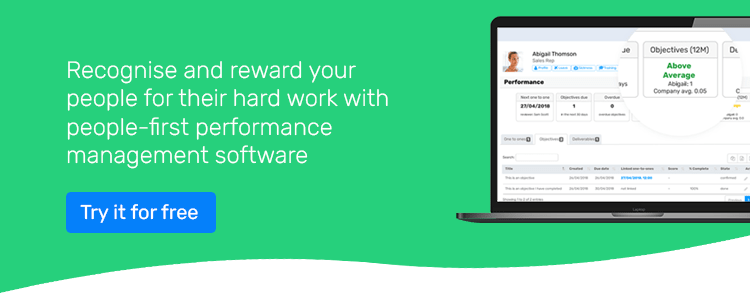What springs to mind when you see the words ‘performance management’?
Do your palms grow sweaty at the slightly soul-destroying memory of experiencing a perfectly tepid review, resulting in the dreaded words of the working world: ‘meets expectations’?
Shudder. The point is it’s not very motivational to be told you’re average, or that your work is ‘fine’ – especially when you’re working as hard as you can. And the same goes for your team, along with the way you’re managing performance within your SME.
But rather than wanting to throw your laptop out of the window and emigrate to New Zealand at the staleness of it all, what if we told you there was a different way for HR to approach employee performance management? What if there was a performance model that achieves both what your business needs and what your team wants?
Read on, where we delve into the concept of employee-led performance management, its benefits, and how SMEs can overcome the barriers to implement it successfully.
In this blog, we spoke to Breathe Partner, Helen Price-Evans for her insights & advice. Helen is a CIPD-qualified HR Consultant and Director of Starfish People HR, with over 20 years of HR management & coaching experience.
Skip to:
-
What are the benefits of letting employees take charge of their own performance?
-
Helen's 3 key tips to supporting employees with the shift to performance autonomy
-
How HR can help leaders with the transition to employee-led performance
The pitfalls of traditional performance management
Performance reviews have long been seen as outdated, stagnant, tedious, and time-consuming. We all know the drill, and for many employees, they're nothing more than a tick-box exercise or an annual ritual where they receive a score that does little to motivate them.
The problem lies in the top-down mentality and methodology that these traditional reviews follow. Employees are handed objectives, and at the end of the year they receive a score in a range of demoralising neutrality.
There's little room for motivation, empowerment, or engagement in such a system. But what if there's a better way to do it? Enter employee-led performance management.
Our HR Partner, Helen Price-Evans of Starfish People HR shares her expert thoughts around the employee-led performance management model:
“An employee-led performance model supports increased accountability – rather than working passively, employees are more likely to make & own decisions, and to learn from mistakes.
Empowering your team in this way is a hugely positive cycle and strengthens your culture massively – it boosts ‘the way we do things around here’ for the better.”
What is employee-led performance management?
Employee-led performance management means performance models that are initially driven by employees, incorporating their suggestions & ideas, rather than these filtering down from leaders and managers.
Helen Price-Evans of Starfish People HR notes that this may startle some managers and senior leaders, clarifying the model. “[Employee-driven performance management] doesn’t mean that employees have complete free rein to do whatever they like, just that they’re given the autonomy and freedom to explore the avenues that interest them, relating to their career development.”
Helen shared some helpful insights for SMEs on shifting the balance from top-down performance models to an employee-driven one.
What are the benefits of letting employees take charge of their own performance?
Helen Price-Evans of Starfish People HR emphasises two main benefits of empowering your team: employee engagement and motivation. Employee-led performance encourages individuals to take responsibility for their work, instilling a sense of empowerment and accountability. “When employees feel in control of their destiny, they look forward to work - which then contributes to a positive work culture,” Helen observes.
Hear how Helen describes a healthy company culture.
“If people feel responsible for what they do at work, in control, accountable & empowered – the entire culture of the goldfish bowl means it swims well in the same direction.
However, if the culture isn’t strong, if leaders don’t know how to unlock the potential in their people and you just keep hiring people and dropping more goldfish into the bowl – it often results in chaos. I like to think of HR as helping to create the environment that gives people enough room to swim in.”
Top 6 benefits of employee-led performance
We’ve listed the top 6 benefits of implementing an employee-driven performance management culture:
1. Increased accountability
As Helen mentioned, employees are likely to engage more with their objectives if they’ve suggested them & be more productive. They’re also more likely to claim ownership of their work early on, if it was their idea initially – meaning projects move quickly and more work is likely to be completed.
2. Supports culture of open communication
Teams are more likely to feel listened to and a part of the organisation if their points are taken into account, rather than being dictated to – especially when it comes to their own personal development & how performance is managed.
3. Saves time
Giving employees the power to come up with their own objective ideas reduces the admin burden on line managers, who might be required to consistently come up with new ideas for objectives for their whole team on a regular basis. It also saves a lot of time – after all, two (or more) brains are better than one.
4. Cost-effective
SMEs with a smaller budget don’t have to spend a lot on outsourcing solutions to get creative with their performance management – instead, why not put it to your team, re-energising their approach to their own performance and reach some creative solutions? Sounds like a win-win.
5. It keeps morale high
Everyone likes feeling listened to and that their voice has value, which can help to boost morale and resilience through turbulent (business/economic) times.
6. Simplifies L&D
Ideas for growth areas could be highlighted more easily if employees have to self-assess – this can also support retention, and keeping existing employees engaged in their roles.

3 key tips to support employees with the shift to performance autonomy
It’s not always an easy shift, adjusting mindsets throughout your SME to thinking about performance differently. And it’s not just managers and leaders who may struggle (we’ll get to that later).
Helen advises that some employees may hesitate to embrace this level of autonomy due to the prevailing top-down culture. Essentially, psychological safety is a critical component in being able to implement employee-led performance to your business.
Hear Helen's thoughts around why employees may struggle with this shift:
“If employees are hesitant to embrace autonomy over their own performance, this is likely because the organisational culture is one where they’ve not previously been empowered.
It could be because they don’t trust the new system, or perhaps don’t believe in it. It could also be down to confidence – perhaps they might fear their ideas not being well-received.”
If this sounds like a possibility within your SME, Helen recommends laying the following foundations to get the most out of changing your performance model & supporting your people:
1. Ensure the environment is conducive to self-assessment and feedback
This addresses the situation where employees are hesitant – take a look at why this might be. Employees may be wondering whether they trust the new performance model – perhaps they would like to be involved, but are wondering if it’s safe.
2. Establish peer support groups to foster open communication and encourage honest discussions
Sometimes people might just need to bolster their confidence before embarking on a new way of doing things.
“Setting up peer support groups are a simple and cost-effective way to create a safe space for people to voice their concerns, and to share encouragement. You don’t need to be a big company with a large budget to do this either – and it can make all the difference,” Helen notes.
3. Offer mentoring opportunities to share tacit knowledge and build confidence in embracing employee-led performance
In Helen’s experience, she notes that often a lot of knowledge within an SME is tacit knowledge – things that people inherently know due to working somewhere for a long time, but that isn’t detailed in any training notes or handbook. “Proper mentoring – not to be confused with coaching – is really useful for sharing and building knowledge.
“Offering a mentoring programme can really help to ensure that employee-led performance is a success within your business. It’s important that mentors are someone else than the employee’s line manager. Mentoring can help with personal development, confidence & communication.”
Laying these foundations can help an employee-driven performance management culture to thrive, and gain buy-in from your team.
How HR can help leaders with the transition to employee-led performance
It’s vital for business leaders & managers to invest in new performance models for them to succeed. But getting everyone on board isn’t always easy – so we asked the HR expert, Helen Price-Evans of Starfish People HR, for some advice around this.
When asked how HR can encourage business leaders to embrace this shift, Helen emphasised the importance of trust, respect, and communication.
“[Leaders] won’t overtly say they’re reluctant [to move to an employee-led performance mindset], but HR can often observe this in the language used around this topic.
For some managers or leaders, it can be fear-based reluctance from not fundamentally trusting their team enough. It’s often about how you frame this to leaders, as HR – why not position it as this will allow talented people to free up more time and headspace for the leadership team, or for managers? Creating the right environment for people to grow and flourish is beneficial for everyone.”
Emphasising individual strengths & creating more innovation within your SME can only be a good thing – so if you sense reluctance from leaders, it could be framed this way.
Helen also notes that it’s important to reassure management that employee-led performance isn’t about giving employees complete freedom – a structure that is aligned to business needs and goals should remain, but your people should feel empowered and motivated in their roles and their position within the SME.
For SMEs accustomed to traditional top-down approaches, Helen suggests a gradual transition, focusing on building trust, communication, and letting go of control. No one wants to unnerve their workforce by making drastic changes all at once. Managers play a pivotal role in facilitating this shift, with training and effective communication functioning as the key elements to achieving success.
How Breathe’s performance management software can empower your team
As a Breathe HR Partner, Helen shared some examples of times she’s witnessed Breathe streamline processes for her SME clients, saving time and empowering employees with access to their own information.
“In some SMEs who might be small businesses with only a few employees, things like performance objectives or holiday requests might still be held on bits of paper or in a spreadsheet that one person controls.
Allowing employees to have access to their own information in software like Breathe, allows people to bypass lengthy procedures and gives people true ownership & empowerment.”
In a world where employee empowerment & engagement are essential for success, the concept of employee-led performance management offers SMEs a fresh perspective. By breaking away from the traditional top-down approach and adopting a more inclusive, empowering, and communication-driven model, businesses can achieve higher levels of employee engagement, motivation & productivity.
As Helen notes, “true employee-led performance means holding the ladder to help your team climb it, rather than climbing it yourself. It's about creating an environment where everyone can flourish and grow.”
Employee-led performance might just be the change your SME needs to thrive in today's dynamic workplace.
Find out how Breathe’s performance management software can help you to empower your team today by taking out a free trial.
Helen Price-Evans is a CIPD-qualified HR Consultant and Director of Starfish People HR, with over 20 years of HR management & coaching experience.
Starfish People HR are HR Partners of Breathe.

Author: Aimée Brougham-Chandler
An IDM-certified Digital Copywriter as of February 2023, Aimée is Breathe's Content Assistant. With a passion for guiding readers to solutions for their HR woes, she enjoys delving into & demystifying all things HR: From employee performance to health and wellbeing, leave to company culture & much more.





